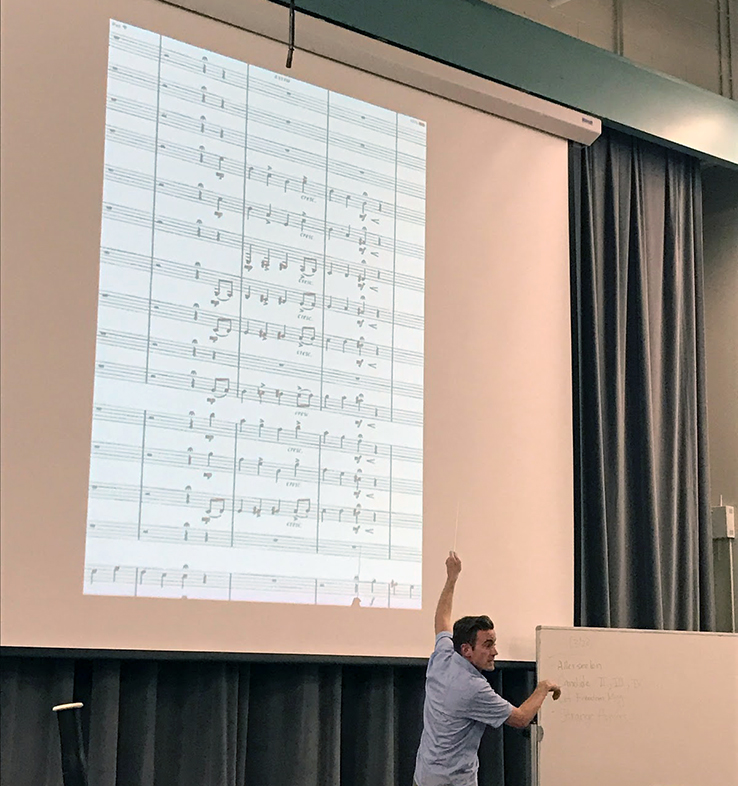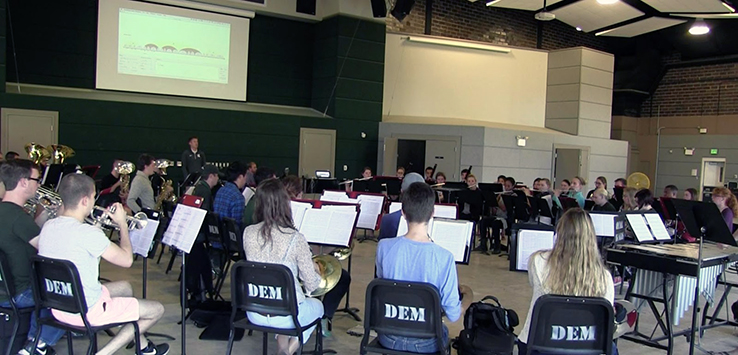
We come to each rehearsal with various objectives, numerous musical ideas, and a plan to achieve those goals. As we progress through the rehearsal, are we teaching at the students or are we teaching and working with them? How can we help them develop their musicianship, listen more critically, and to work together better in the context of our rehearsals?
Creating a “student-centered” rehearsal environment helps students take ownership of their playing and be more active in the ensemble experience. Hopefully, we are giving them the tools that they need to refine their own musicianship, help those around them, and contribute to the ensemble beyond their section or row.
Listening is Critical
One of our biggest challenges is developing a student’s individual and ensemble listening skills. Learning how to listen to oneself, those around you, and across the ensemble is a complex process that develops over time. How can we help?
Think about what listening concepts you want your students to apply when they are playing in an ensemble. What are the “buzzwords” that you can use than can immediately refocus their ears and intention? Describing levels of listening gives direction, while also creating layers and a guide on where the student can focus.
Levels of Listening
- Solo (the student)
- Trio (the person on either side, in front or behind them)
- Section (clarinet, trumpet, percussion)
- Choir (woodwind, brass, percussion)
- Ensemble (whole group)
Consider your concept of listening to the ensemble as well. Are we simply listening for things that go wrong? Or are we listening in such a way that we have a goal “sound” in mind that we can help them achieve? If we are constantly hearing mistakes and ONLY responding to those, we never give the ensemble a sense of where the level of music needs to be, only where it shouldn’t.
Ask Questions
Engaging the students with dialogue directs their listening in a rehearsal and makes it interactive.
Helping the students make discoveries beyond the print can be a challenge, but also equally rewarding. At first, your students may be hesitant about speaking their minds, but you can help build their confidence by asking more leading questions to start. Over time, you will find that more generic questions will generate numerous talking points.
Try these questions or come up with your own:
- What are you hearing?
- Where is this line going?
- What is the mood?
- How can we play more _______?
- Where is the biggest/softest moment of the phrase?
- What might be the composer’s intention?
- Why?
This last question is the most important. It helps the students draw conclusions based on their discovery of several musical details. This is also a great time to share with them the discoveries from your score study! “I believe the music is telling us to do this, because of this, this, and this in the score.”
Empower your students
We are all looking for ways to give our students more tools or information to help them perform better. With these tools we can hopefully help our students have a higher level of understanding and feel more connected to the music.
- Use a projector to display the score. This can be very helpful when explaining details about the music.

- Smartboards can be even more useful than a projector. Being able to annotate on the screen adds another layer to your display capabilities.
- Have the students use the full score as their part. (Don’t forget to ask permission from the composer.)
- If a piece has reference to an historical or social event, or has some other historical or cultural context, use that narrative in your teaching. The students will enjoy making connections in the music from the subject matter.
Other Activities
The following activities could be implemented in any teaching setting or level with appropriate application/modification.
– Music Listening Activity
Take one minute have your students listen to a quick music excerpt. It can be any type of music or group! Have them keep a log describing what they hear as it relates to: melody, harmony, form, rhythm, articulation, texture, timbre, color, and feeling. Then take thirty seconds to have a few students share their findings. This activity helps develop depth in their listening and gives them a bigger vocabulary to use in rehearsals.
– Student Leadership
In our marching band programs we often have section leaders, squad leaders, drill assistants who help clean drill or assist with sectionals. What if we could find a way to have similar roles in our concert band groups? Create opportunities for students to give feedback to their peers or work together in their sections.
– The White Sheet
Pass out half sheets of paper to every member of your ensemble. Run through a section of your music and then give them thirty seconds to a minute to write down what they heard in their own playing, in their section, and across the ensemble. Next, ask them to share what they heard with the ensemble to create dialogue. This can be a great teaching/learning environment for the ensemble which can ultimately lead to a rehearsal guided by the student feedback!
– Un-conducted Rehearsals
Sometimes it is valuable to not conduct at all and allow the students to take ownership of the music. This also allows us as directors to listen to the ensemble and offer feedback in a different way. As you incorporate this technique into your rehearsals the music may fall apart. This failure can be an important lesson! It can help direct their listening to the “motor” of the music or the more important melodic line. When the students see that you trust them with the pulse, you are freed to show more music!
– Student-led Rehearsals
This would be the ultimate “white sheet rehearsal” as we, the teacher, remove ourselves from the rehearsal process entirely – similar to the Orpheus Chamber Orchestra model. With a set of guidelines and procedures for the rehearsal, students could learn to give constructive feedback, rehearse different parts of their music, and agree on interpretive decisions all without the teacher’s assistance. This process can take time to develop, but is very rewarding in the end for both the students and the teacher!

The Michigan State University Concert Band in a “student-led” rehearsal on Steven Bryant’s Dusk while using a Variations Timeliner projection as a rehearsal tool.
Variations Timeliner
The Variations Timeliner is a wonderful, free program developed by Indiana University that can be found online here. This program allows you to sync music to a “timeline” which can be developed to create a visual representation of the form, compare and contrast sections, make annotations, etc. You might find this useful in your score study and teaching. Click the video below for a short demo!
It’s our hope that this “Making Musical Decisions” series (including earlier posts on score study and gesture) has been helpful to you and your students. We are all in a process of improving ourselves as music educators and being better for our students. The techniques of score study, gesture, and implementing rehearsal techniques are always in a state of refinement. The more we work thoughtfully and creatively, the easier that process becomes.
It is also important to realize these ideas are not “just for high school or upper-level musicians”; score study can improve your middle school rehearsals, working on gesture CAN have an effect on your beginning ensemble, and efficient and student-centered rehearsals will improve musicianship for students of all ages.

